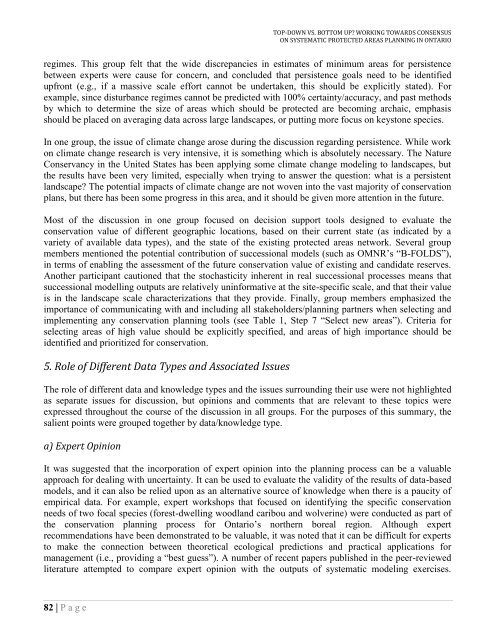Top-Down vs. Bottom Up: Working Towards Consensus ... - CASIOPA
Top-Down vs. Bottom Up: Working Towards Consensus ... - CASIOPA
Top-Down vs. Bottom Up: Working Towards Consensus ... - CASIOPA
- No tags were found...
You also want an ePaper? Increase the reach of your titles
YUMPU automatically turns print PDFs into web optimized ePapers that Google loves.
TOP-DOWN VS. BOTTOM UP? WORKING TOWARDS CONSENSUSON SYSTEMATIC PROTECTED AREAS PLANNING IN ONTARIOregimes. This group felt that the wide discrepancies in estimates of minimum areas for persistencebetween experts were cause for concern, and concluded that persistence goals need to be identifiedupfront (e.g., if a massive scale effort cannot be undertaken, this should be explicitly stated). Forexample, since disturbance regimes cannot be predicted with 100% certainty/accuracy, and past methodsby which to determine the size of areas which should be protected are becoming archaic, emphasisshould be placed on averaging data across large landscapes, or putting more focus on keystone species.In one group, the issue of climate change arose during the discussion regarding persistence. While workon climate change research is very intensive, it is something which is absolutely necessary. The NatureConservancy in the United States has been applying some climate change modeling to landscapes, butthe results have been very limited, especially when trying to answer the question: what is a persistentlandscape? The potential impacts of climate change are not woven into the vast majority of conservationplans, but there has been some progress in this area, and it should be given more attention in the future.Most of the discussion in one group focused on decision support tools designed to evaluate theconservation value of different geographic locations, based on their current state (as indicated by avariety of available data types), and the state of the existing protected areas network. Several groupmembers mentioned the potential contribution of successional models (such as OMNR‟s “B-FOLDS”),in terms of enabling the assessment of the future conservation value of existing and candidate reserves.Another participant cautioned that the stochasticity inherent in real successional processes means thatsuccessional modelling outputs are relatively uninformative at the site-specific scale, and that their valueis in the landscape scale characterizations that they provide. Finally, group members emphasized theimportance of communicating with and including all stakeholders/planning partners when selecting andimplementing any conservation planning tools (see Table 1, Step 7 “Select new areas”). Criteria forselecting areas of high value should be explicitly specified, and areas of high importance should beidentified and prioritized for conservation.5. Role of Different Data Types and Associated IssuesThe role of different data and knowledge types and the issues surrounding their use were not highlightedas separate issues for discussion, but opinions and comments that are relevant to these topics wereexpressed throughout the course of the discussion in all groups. For the purposes of this summary, thesalient points were grouped together by data/knowledge type.a) Expert OpinionIt was suggested that the incorporation of expert opinion into the planning process can be a valuableapproach for dealing with uncertainty. It can be used to evaluate the validity of the results of data-basedmodels, and it can also be relied upon as an alternative source of knowledge when there is a paucity ofempirical data. For example, expert workshops that focused on identifying the specific conservationneeds of two focal species (forest-dwelling woodland caribou and wolverine) were conducted as part ofthe conservation planning process for Ontario‟s northern boreal region. Although expertrecommendations have been demonstrated to be valuable, it was noted that it can be difficult for expertsto make the connection between theoretical ecological predictions and practical applications formanagement (i.e., providing a “best guess”). A number of recent papers published in the peer-reviewedliterature attempted to compare expert opinion with the outputs of systematic modeling exercises.82 | P a g e


